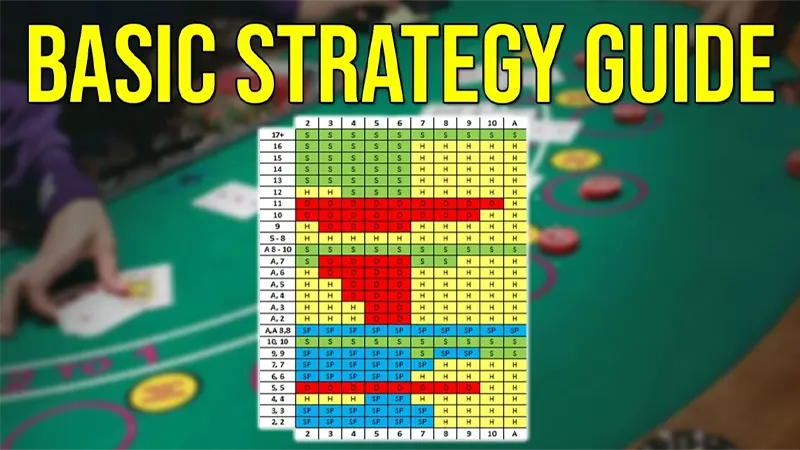Blackjack stands out as one of the most fascinating card games in the casino world, offering a unique combination of luck and strategy that sets it apart from pure games of chance. Unlike roulette or slot machines, Blackjack presents players with meaningful decisions that directly impact their outcomes. Players aren’t just competing against the cards—they’re engaging in an intellectual battle with the house, making strategic choices that can significantly influence their long-term success.
Despite Blackjack’s relatively simple rules, many newcomers fall into predictable traps that lead to consistent losses. The majority of inexperienced players rely heavily on intuition, gut feelings, or superstitious beliefs when making crucial decisions. They might hit on 16 against a dealer’s 6 because it “feels right,” or stand on 12 against a dealer’s 10 because they’re afraid of busting. This approach, while understandable, ignores the mathematical realities underlying every hand.
Enter Basic Strategy: Your Mathematical Advantage
This is where Basic Strategy emerges as a game-changer—a mathematically derived tool that provides optimal decisions for every possible situation in Blackjack. Rather than relying on hunches or emotional impulses, Basic Strategy offers a systematic approach based on statistical analysis and probability calculations. Within the broader framework of Blackjack Strategy, Basic Strategy serves as the fundamental cornerstone that every serious player must master.
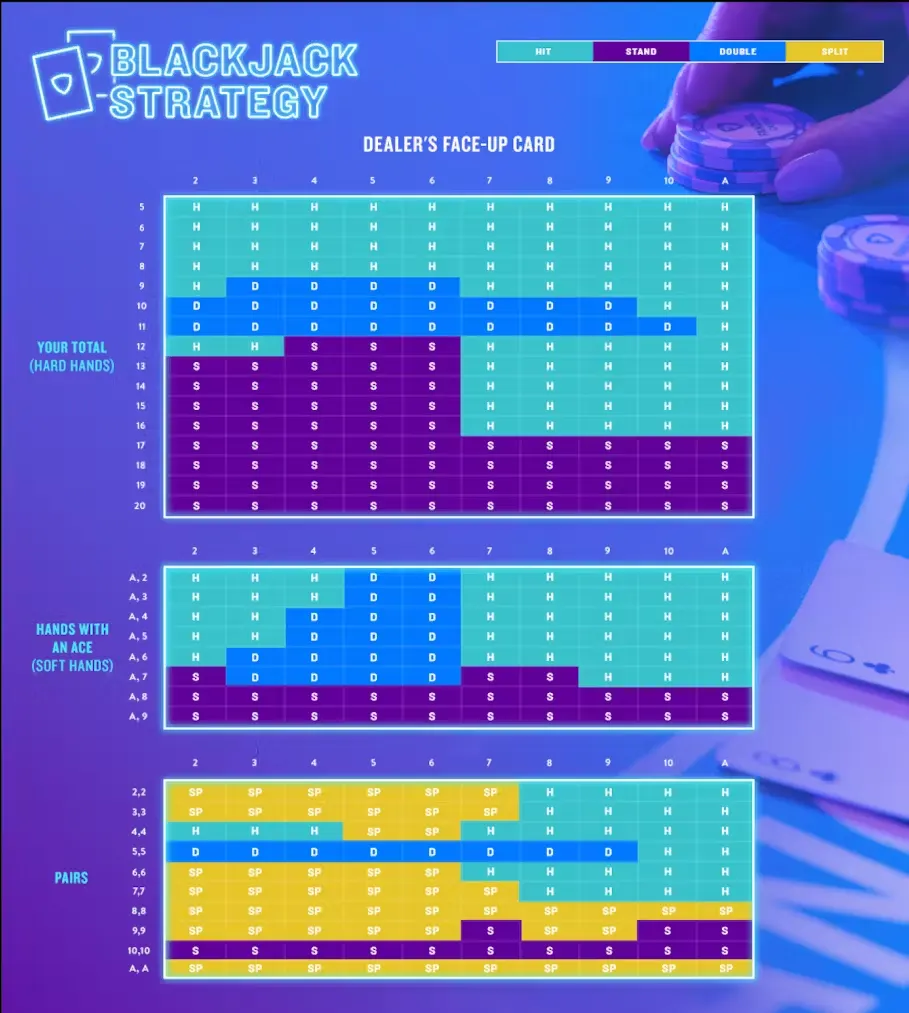
The primary objective of this comprehensive guide is to demystify Basic Strategy, explain why it’s so effective, and provide practical methods for learning and implementing it successfully. We’ll pay special attention to its application in online environments like 91 Club, where players have unique advantages for studying and applying these strategic principles.
Understanding Basic Strategy: The Mathematical Foundation
Basic Strategy represents a comprehensive decision-making framework that tells players exactly what action to take in every possible Blackjack scenario. This isn’t guesswork or general advice—it’s a precise mathematical system that specifies whether to hit, stand, double down, split pairs, or surrender based on your hand total and the dealer’s visible card. Every recommendation in Basic Strategy has been calculated to provide the statistically optimal outcome over millions of hands.
Historical Development and Scientific Origins
The development of Basic Strategy represents one of the greatest achievements in gambling mathematics. This system wasn’t created through casual observation or anecdotal experience—it emerged from rigorous computer simulations that analyzed millions upon millions of Blackjack hands. Early pioneers like Edward Thorp and Julian Braun used primitive computers in the 1960s to calculate the optimal play for every possible combination of player cards and dealer upcards.
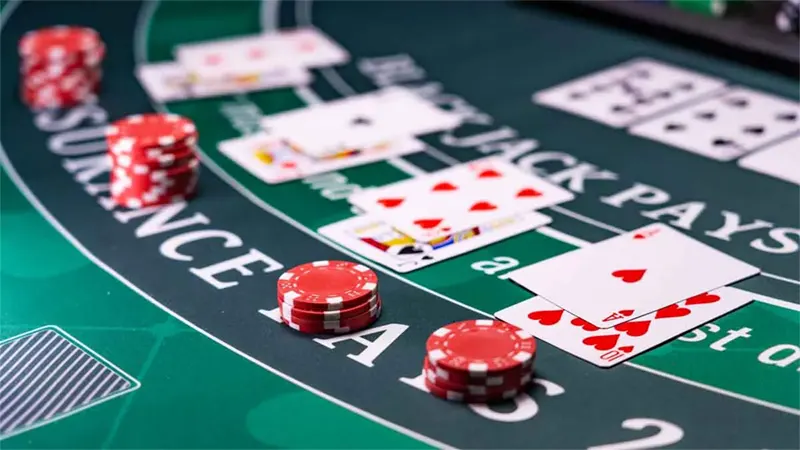
These mathematicians didn’t rely on intuition or gambling folklore. Instead, they employed statistical analysis and probability theory to determine which actions yielded the highest expected value in each situation. The result was a complete strategy that could reduce the house edge to its absolute minimum through perfect mathematical play.
Strategic Objectives and Realistic Expectations
The primary goal of Basic Strategy isn’t to guarantee wins—no strategy can accomplish that in a game with inherent house edge. Instead, Basic Strategy aims to minimize losses and maximize the value of favorable situations. When implemented perfectly, Basic Strategy can reduce the house edge to approximately 0.5% or even lower, depending on specific game rules and conditions.
This reduction might seem modest, but its impact is profound over extended play. The difference between a 2% house edge (typical for players using no strategy) and a 0.5% house edge represents a four-fold improvement in expected outcomes. For players planning hundreds or thousands of hands, this mathematical advantage translates into significantly better results and longer-lasting bankrolls.
How Basic Strategy Operates: Understanding the Mathematics
Fundamental Principles Behind Optimal Play
Basic Strategy operates on the principle that every Blackjack decision can be mathematically optimized based on probability calculations. The strategy considers the known information—your cards and the dealer’s upcard—and determines which action provides the highest expected value. This mathematical approach removes emotional decision-making and replaces it with statistically sound choices.
The foundation lies in understanding that certain situations favor the player while others favor the dealer. For example, when you hold 16 against a dealer’s 10, Basic Strategy recommends hitting despite the high risk of busting. This recommendation exists because mathematical analysis proves that hitting provides a better long-term outcome than standing, even though both options have negative expected values.
Key Factors Influencing Strategic Decisions
Several critical factors determine the optimal play in any given situation. Your hand total forms the primary consideration, but the composition of your hand also matters significantly. A hard 16 (composed of cards like 10-6) plays differently than a soft 16 (like A-5), because the soft hand contains an Ace that can be counted as either 1 or 11.
The dealer’s upcard provides crucial information for decision-making. Weak dealer upcards (2-6) suggest the dealer has a higher probability of busting, making conservative play more attractive. Strong dealer upcards (7-A) indicate the dealer likely has a strong hand, requiring more aggressive player actions to compete effectively.
Game-specific rules also influence optimal strategy. The ability to double down after splitting, the number of decks in play, surrender options, and dealer hitting or standing on soft 17 all affect the mathematically correct decisions in various situations.
Structure of the Basic Strategy Chart
The standard Basic Strategy chart divides into three distinct sections, each addressing different types of hands players might receive.
Hard Hands Strategy
Hard hands contain no Aces or have Aces that must be counted as 1 to avoid busting. These hands form the majority of situations players encounter. The hard hands section covers totals from 5 through 17, providing clear guidance for each scenario against every possible dealer upcard.
For example, the strategy for hard 12 varies depending on the dealer’s showing card. Against dealer upcards of 2 or 3, Basic Strategy recommends hitting because the dealer’s relatively weak position doesn’t justify the risk of standing on such a low total. However, against dealer upcards of 4, 5, or 6, standing becomes optimal because the dealer’s bust probability is high enough to make conservative play profitable.
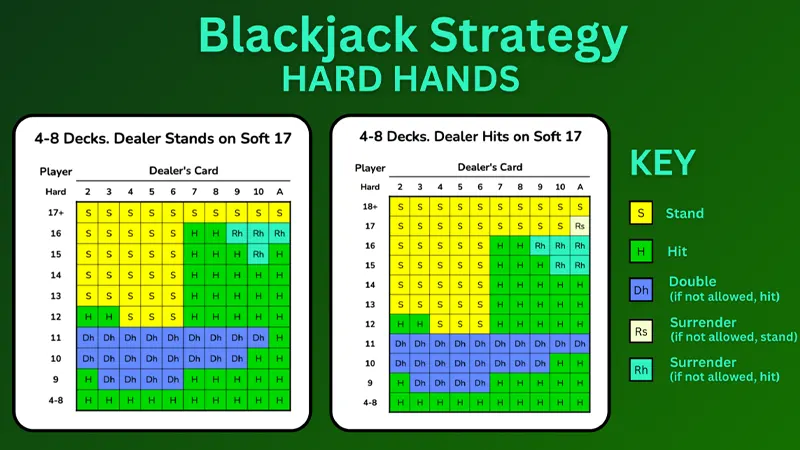
Soft Hands Strategy
Soft hands contain an Ace that can be counted as 11 without causing a bust. These hands offer unique strategic opportunities because they can’t be busted with a single additional card. The flexibility of soft hands allows for more aggressive play, including doubling down in situations where hard hands would require conservative approaches.
A soft 17 (A-6) exemplifies this strategic difference. While a hard 17 virtually always calls for standing, a soft 17 often benefits from doubling down against weak dealer upcards. The presence of the flexible Ace creates opportunities for improvement that don’t exist with hard totals.
Pair Splitting Decisions
When dealt identical cards, players face the additional option of splitting their pair into two separate hands. Pair splitting decisions depend on balancing the strength of the original hand against the potential of two new hands, while considering the dealer’s upcard strength.
Some pairs, like Aces and 8s, should almost always be split regardless of the dealer’s upcard. Other pairs, like 5s and 10s, should rarely or never be split. The remaining pairs require situation-specific analysis based on the dealer’s showing card.
Learning Basic Strategy: Practical Methods and Techniques
The most sustainable approach involves dividing Basic Strategy into logical segments and mastering each section before progressing. This method prevents cognitive overload while ensuring solid retention of learned material.
Week 1-2: Hard Hands Mastery Focus exclusively on hard hand totals from 5-17 against all dealer upcards. These situations represent the majority of decisions players face, making them the highest priority for initial study.
Week 3-4: Soft Hands Integration
Add soft hand strategies while maintaining hard hand proficiency. Soft hands often surprise new students because they frequently call for more aggressive play than intuition suggests.
Week 5-6: Pair Splitting Completion Complete the strategy by learning optimal pair splitting decisions. This section requires understanding the value of creating two hands versus keeping the original pair intact.
Timeline for Achieving Proficiency
Most dedicated students can achieve functional Basic Strategy knowledge within 2-3 weeks of consistent daily practice. However, true proficiency—the ability to make correct decisions automatically without conscious thought—typically requires 1-2 months of regular reinforcement.
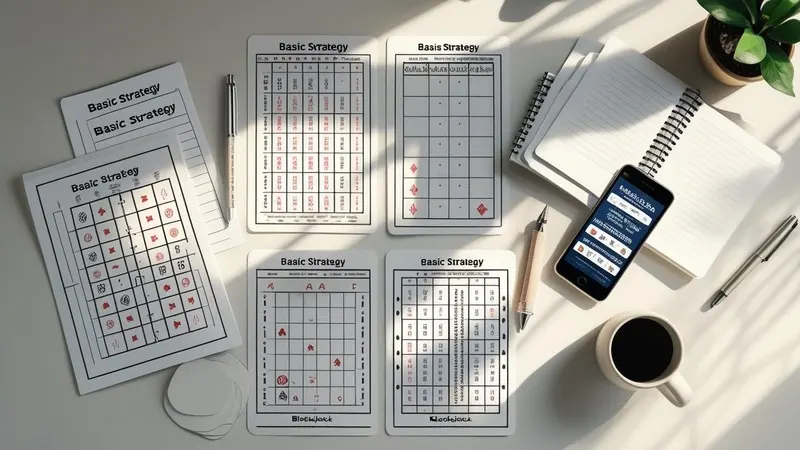
The timeline varies significantly based on study intensity and individual learning styles. Players who practice 15-20 minutes daily typically progress faster than those who attempt longer, less frequent study sessions. Consistency matters more than duration when building strategic memory.
Implementation Tips for 91 Club Players
Online platforms like 91 Club offer unique advantages for Basic Strategy implementation and practice. The private nature of online play eliminates performance anxiety while allowing unlimited strategy consultation during the learning phase.
Practice Mode Utilization
Most online casinos offer free-play or demo modes that provide perfect environments for strategy practice. Use these modes extensively before transitioning to real-money play, ensuring your strategic knowledge is solid and automatic.
Gradual Transition Strategy
Begin real-money play with minimum bet sizes while your strategy knowledge solidifies. This approach minimizes financial risk while providing authentic playing experience that differs from practice mode conditions.
Understanding Basic Strategy’s Limitations and Boundaries
Significant Advantages and Strengths
Basic Strategy provides numerous benefits that make it essential knowledge for any serious Blackjack player. The most obvious advantage lies in its ability to dramatically reduce the house edge through mathematically optimal play. While the casino maintains an advantage even against perfect Basic Strategy play, this edge decreases to its theoretical minimum of approximately 0.5% under favorable conditions.
- Legal and Ethical Advantages
Unlike more advanced techniques such as card counting strategy in Blackjack, Basic Strategy enjoys complete legal and social acceptance. Casinos welcome Basic Strategy players because the technique doesn’t eliminate the house edge entirely. Players can openly reference strategy charts, discuss optimal plays, and even receive comp benefits based on their action—privileges not extended to advantage players using more sophisticated methods.
- Accessibility and Learning Curve
Basic Strategy’s relatively gentle learning curve makes it accessible to players of all skill levels and mathematical backgrounds. The strategy doesn’t require advanced calculations, card tracking, or complex betting progressions. Once learned, Basic Strategy provides consistent guidelines that work in virtually any Blackjack variant or casino environment.
Realistic Limitations and Expectations
Despite its benefits, Basic Strategy cannot overcome the fundamental mathematics of casino games. Players must understand that even perfect strategic play cannot guarantee profits or eliminate the possibility of losing sessions.
- Short-Term Variance Reality
Basic Strategy optimizes long-term expected value but cannot control short-term variance. Players will experience winning and losing streaks regardless of their strategic proficiency. The strategy’s benefit emerges over hundreds or thousands of hands, not individual sessions or daily results.
- Psychological and Emotional Challenges
Basic Strategy provides mathematical guidance but doesn’t address the psychological challenges of casino play. Players may understand the correct strategic play while struggling to implement it under stress, fatigue, or emotional pressure. The strategy works only when followed consistently, regardless of recent results or emotional state.
- Implementation Errors and Deviations
Even knowledgeable players sometimes deviate from Basic Strategy due to impatience, frustration, or overconfidence. These deviations, however minor they might seem, can significantly impact long-term results. The strategy’s effectiveness depends entirely on consistent, disciplined implementation.
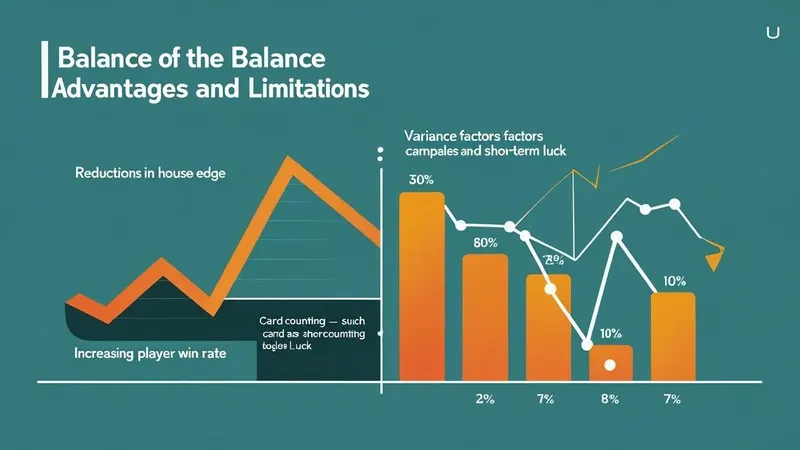
Integration with Complementary Strategies
Basic Strategy works best when combined with sound gambling principles and complementary techniques that address its limitations.
- Bankroll Management Integration
Proper money management amplifies Basic Strategy’s effectiveness by ensuring players can survive short-term variance while the strategic edge manifests over time. This includes setting appropriate bet sizes relative to total bankroll, establishing win/loss limits, and maintaining adequate reserves for extended play.
- Emotional Control and Discipline
Mental preparation and emotional discipline help ensure consistent Basic Strategy implementation. This includes accepting that losses are inevitable, maintaining perspective during both winning and losing streaks, and avoiding the temptation to chase losses with larger bets or strategic deviations.
- Game Selection and Rule Optimization
Smart players combine Basic Strategy knowledge with careful game selection, choosing tables with favorable rules that minimize the house edge. This includes seeking games that allow doubling after splitting, offer surrender options, pay 3:2 for blackjacks, and require dealers to stand on soft 17.
Platform-Specific Considerations for 91 Club
Online platforms like 91 Club present unique opportunities and challenges for Basic Strategy implementation. The digital environment offers advantages like unlimited strategy consultation and pressure-free decision making, but also introduces factors like game speed variations and software-specific rule implementations.
Players should familiarize themselves with their chosen platform’s specific rules and interface before implementing real-money strategy. This includes understanding how doubling, splitting, and surrender functions work within the software environment.
The Golden Foundation for 91 Club Blackjack Players
Basic Strategy represents far more than just another gambling system—it embodies the mathematical foundation upon which all successful Blackjack play must be built. For anyone serious about achieving consistent results in Blackjack, mastering Basic Strategy isn’t optional; it’s absolutely essential. The strategy’s ability to reduce the house edge to its theoretical minimum transforms Blackjack from a game of pure chance into a skill-based endeavor where knowledgeable players enjoy measurable advantages.
The benefits extend beyond mere mathematical optimization. Basic Strategy provides confidence and clarity in decision-making, eliminating the doubt and second-guessing that plague uninformed players. When you know the mathematically correct play in every situation, you can focus on execution and bankroll management rather than constantly questioning your strategic choices.
In today’s competitive gaming environment, the difference between informed and uninformed players has never been more pronounced. While recreational players continue relying on intuition and superstition, those who master Basic Strategy gain significant advantages in terms of both results and enjoyment. The strategy doesn’t guarantee wins, but it ensures that every decision is optimized for the best possible long-term outcome.
Online platforms like 91 Club have democratized access to optimal Blackjack strategy by removing many traditional barriers to learning and implementation. The privacy and pace of online play create ideal conditions for mastering these essential skills without the pressure and distractions of physical casino environments.

